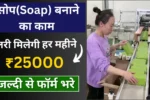Fashion designer jobs are among the most coveted careers in the world, blending creativity, business acumen, and an eye for detail. From haute couture to ready-to-wear lines, the fashion industry offers a plethora of opportunities for aspiring designers.
| ↓ फॉर्म निचे दिया गया हैं ↓ |
This comprehensive guide will delve into the world of fashion designer jobs, exploring key aspects such as job responsibilities, required skills, educational paths, and the highest-paying roles. Whether you’re a budding designer or someone looking to switch careers, this article will provide all the information you need to kickstart your journey in the fashion world.
What Do Fashion Designers Do?
Fashion designers are the creative minds behind the clothing, accessories, and footwear that define global style trends. They are responsible for sketching designs, selecting fabrics, and creating collections that appeal to target audiences. Here’s a detailed look at their core responsibilities:
- Creating Original Designs: Fashion designers conceptualize and create original clothing and accessory designs. They develop sketches, choose colors, and decide on the look and feel of the final product.
- Trend Analysis: Staying updated with current fashion trends is crucial. Designers often research market trends, attend fashion shows, and analyze consumer behavior to keep their designs relevant.
- Fabric Selection and Testing: The choice of fabric can make or break a design. Fashion designers test different materials, ensuring that their designs are not only stylish but also functional and comfortable.
- Collaborating with Other Professionals: Designers frequently work with other professionals, including patternmakers, seamstresses, and fashion buyers, to bring their visions to life.
- Creating Prototypes and Samples: Before a design goes into full production, designers create prototypes to test the fit, look, and overall design.
- Overseeing Production: In many cases, designers are involved in the production process, ensuring that the final product meets quality standards and aligns with the original vision.
- Marketing and Brand Development: Modern fashion designers often engage in marketing and branding, promoting their collections through social media, fashion shows, and collaborations with influencers.
Types of Fashion Designer Jobs
The fashion industry is diverse, offering various types of designer jobs, each with unique responsibilities and opportunities. Here’s a closer look at some of the most popular roles:
- Fashion Illustrator: These designers specialize in creating sketches and illustrations that form the foundation of new collections. They work closely with creative directors and are often involved in the initial design phase.
- Pattern Maker: Pattern makers translate the designer’s sketches into patterns that serve as blueprints for garments. This role requires a deep understanding of garment construction and attention to detail.
- Textile Designer: Textile designers create unique fabrics used in fashion collections. They experiment with patterns, colors, and materials to produce innovative textiles.
- Technical Designer: Technical designers focus on the fit and construction of garments. They ensure that designs are practical and comfortable while maintaining the aesthetic appeal.
- Apparel Designer: Apparel designers create clothing lines for various markets, including women's wear, men's wear, and children’s wear. They work for brands, design houses, or as freelancers.
- Footwear Designer: Specializing in shoes, footwear designers create innovative designs for casual, athletic, and formal footwear. They often collaborate with material experts to ensure comfort and durability.
- Accessory Designer: From handbags to jewelry, accessory designers create products that complement clothing collections. This role requires a keen eye for detail and an understanding of current trends.
- Costume Designer: Costume designers create outfits for theater, film, and television. They work closely with directors and producers to develop costumes that match the character's persona and the production’s setting.
Skills Required for Fashion Designer Jobs
Fashion design is a highly competitive field that requires a combination of artistic talent, technical skills, and business knowledge. Here are some key skills needed for success in fashion designer jobs:
- Creativity and Artistic Ability: Designers must be highly creative, with a flair for color, style, and detail.
- Technical Skills: Proficiency in design software like Adobe Illustrator and CAD (Computer-Aided Design) is essential.
- Sewing and Pattern-Making Skills: Understanding garment construction and having the ability to sew and make patterns can set designers apart.
- Attention to Detail: Designers must be meticulous, ensuring that their designs are flawless from concept to final product.
- Strong Communication Skills: Effective communication with team members, suppliers, and clients is crucial for success.
- Understanding of Fabrics and Textiles: A deep knowledge of fabrics, their properties, and how they behave is necessary to create wearable designs.
- Time Management: Fashion designers often work under tight deadlines, especially when preparing for fashion shows or product launches.
- Business Acumen: Understanding market trends, target audiences, and business operations can help designers succeed in the industry.
|
यहाँ से भरे जानकारी |
Educational Pathways to Become a Fashion Designer
Pursuing a career as a fashion designer often starts with formal education. While talent and creativity are paramount, having a solid educational background can provide a competitive edge. Here’s an overview of common educational paths:
- Bachelor’s Degree in Fashion Design: Most fashion designers hold a bachelor’s degree in fashion design, textiles, or a related field. These programs cover essential topics like pattern making, fashion illustration, sewing techniques, and fashion history.
- Fashion Design Courses and Certifications: Short courses and certifications in specialized areas, such as digital fashion design or sustainable fashion, can enhance your skills and keep you updated with industry trends.
- Internships and Apprenticeships: Gaining hands-on experience through internships or apprenticeships is invaluable. Working under experienced designers can provide insights into the daily workings of the fashion industry.
- Portfolio Development: A strong portfolio showcasing your best work is essential for landing fashion designer jobs. It serves as a visual resume that highlights your style, skills, and creativity.
Top Fashion Design Schools
Attending a top fashion design school can be a game-changer for your career. Here are some renowned institutions known for their fashion programs:
- Parsons School of Design (New York, USA): Known for its cutting-edge curriculum and strong industry connections, Parsons is a top choice for aspiring designers.
- Central Saint Martins (London, UK): This prestigious school has produced some of the biggest names in fashion, including Alexander McQueen and Stella McCartney.
- Fashion Institute of Technology (FIT) (New York, USA): FIT offers a range of fashion-related programs, focusing on both design and business aspects of the industry.
- Royal Academy of Fine Arts (Antwerp, Belgium): Renowned for its avant-garde approach, this school has nurtured some of the world’s most innovative designers.
How to Land High-Paying Fashion Designer Jobs
Breaking into the fashion industry can be challenging, but with the right strategy, you can land lucrative fashion designer jobs. Here are some tips to help you secure high-paying roles:
- Build a Strong Network: Networking is crucial in the fashion industry. Attend fashion shows, workshops, and industry events to connect with professionals and potential employers.
- Gain Experience Through Internships: Internships are a great way to gain practical experience and build connections. Many fashion houses offer internships that can lead to full-time positions.
- Develop a Unique Style: Having a distinct style sets you apart from other designers. Your signature style should reflect your creativity and resonate with your target audience.
- Stay Updated with Industry Trends: Fashion is constantly evolving. Stay ahead of the curve by following the latest trends, technology, and consumer preferences.
- Leverage Social Media: Use platforms like Instagram and TikTok to showcase your designs and build a following. Many designers have gained recognition and clients through social media exposure.
- Work with Established Brands: Gaining experience with well-known brands can enhance your resume and increase your earning potential.
- Explore Freelancing Opportunities: Freelancing offers flexibility and the potential for high earnings. As a freelance fashion designer, you can work with multiple clients, creating unique designs without being tied to a single brand.
Salary Expectations for Fashion Designer Jobs
The salary for fashion designer jobs varies widely based on experience, location, and the type of employer. Here’s an overview of average earnings in the field:
- Entry-Level Designers: Entry-level fashion designers can expect to earn between $40,000 to $60,000 annually. Internships and assistant roles are often the first steps into the industry.
- Experienced Designers: Designers with several years of experience can earn between $70,000 to $100,000 annually, depending on their skills, portfolio, and the company they work for.
- Top Designers and Creative Directors: Those at the top of the industry, such as creative directors or designers for luxury brands, can earn upwards of $150,000 to $300,000 per year or more.
Future Trends in Fashion Design
The fashion industry is rapidly evolving, driven by technological advancements, sustainability concerns, and changing consumer behavior. Here are some key trends shaping the future of fashion designer jobs:
- Sustainable Fashion: There is a growing demand for eco-friendly and sustainable fashion. Designers who can create innovative, sustainable designs are in high demand.
- Digital Fashion and Virtual Runways: The rise of digital fashion and virtual runway shows is transforming how fashion is showcased and consumed. Designers are now exploring 3D design software and augmented reality to create digital collections.
- Personalization and Customization: Consumers are increasingly seeking personalized fashion. Designers who can offer bespoke services, including custom fits and unique designs, are gaining a competitive edge.
- Tech-Infused Fashion: Wearable technology, smart fabrics, and fashion-tech


